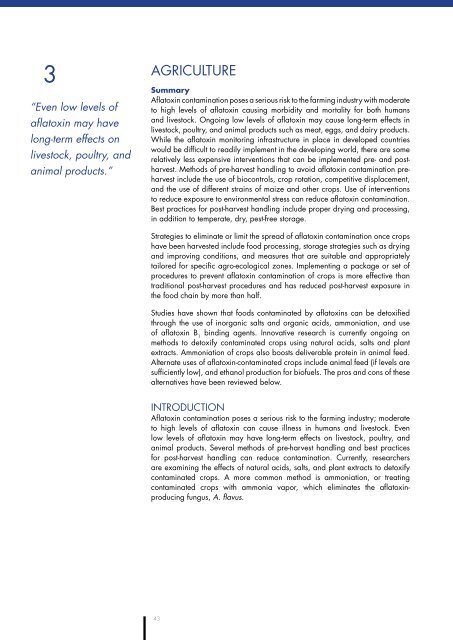Aflatoxin: A Synthesis of the Research in Health, Agriculture and Trade
Aflatoxin: A Synthesis of the Research in Health, Agriculture and Trade
Aflatoxin: A Synthesis of the Research in Health, Agriculture and Trade
You also want an ePaper? Increase the reach of your titles
YUMPU automatically turns print PDFs into web optimized ePapers that Google loves.
3<br />
“Even low levels <strong>of</strong><br />
aflatox<strong>in</strong> may have<br />
long-term effects on<br />
livestock, poultry, <strong>and</strong><br />
animal products.”<br />
AGRicUltURe<br />
Summary<br />
<strong>Aflatox<strong>in</strong></strong> contam<strong>in</strong>ation poses a serious risk to <strong>the</strong> farm<strong>in</strong>g <strong>in</strong>dustry with moderate<br />
to high levels <strong>of</strong> aflatox<strong>in</strong> caus<strong>in</strong>g morbidity <strong>and</strong> mortality for both humans<br />
<strong>and</strong> livestock. ongo<strong>in</strong>g low levels <strong>of</strong> aflatox<strong>in</strong> may cause long-term effects <strong>in</strong><br />
livestock, poultry, <strong>and</strong> animal products such as meat, eggs, <strong>and</strong> dairy products.<br />
While <strong>the</strong> aflatox<strong>in</strong> monitor<strong>in</strong>g <strong>in</strong>frastructure <strong>in</strong> place <strong>in</strong> developed countries<br />
would be difficult to readily implement <strong>in</strong> <strong>the</strong> develop<strong>in</strong>g world, <strong>the</strong>re are some<br />
relatively less expensive <strong>in</strong>terventions that can be implemented pre- <strong>and</strong> postharvest.<br />
Methods <strong>of</strong> pre-harvest h<strong>and</strong>l<strong>in</strong>g to avoid aflatox<strong>in</strong> contam<strong>in</strong>ation preharvest<br />
<strong>in</strong>clude <strong>the</strong> use <strong>of</strong> biocontrols, crop rotation, competitive displacement,<br />
<strong>and</strong> <strong>the</strong> use <strong>of</strong> different stra<strong>in</strong>s <strong>of</strong> maize <strong>and</strong> o<strong>the</strong>r crops. Use <strong>of</strong> <strong>in</strong>terventions<br />
to reduce exposure to environmental stress can reduce aflatox<strong>in</strong> contam<strong>in</strong>ation.<br />
Best practices for post-harvest h<strong>and</strong>l<strong>in</strong>g <strong>in</strong>clude proper dry<strong>in</strong>g <strong>and</strong> process<strong>in</strong>g,<br />
<strong>in</strong> addition to temperate, dry, pest-free storage.<br />
Strategies to elim<strong>in</strong>ate or limit <strong>the</strong> spread <strong>of</strong> aflatox<strong>in</strong> contam<strong>in</strong>ation once crops<br />
have been harvested <strong>in</strong>clude food process<strong>in</strong>g, storage strategies such as dry<strong>in</strong>g<br />
<strong>and</strong> improv<strong>in</strong>g conditions, <strong>and</strong> measures that are suitable <strong>and</strong> appropriately<br />
tailored for specific agro-ecological zones. implement<strong>in</strong>g a package or set <strong>of</strong><br />
procedures to prevent aflatox<strong>in</strong> contam<strong>in</strong>ation <strong>of</strong> crops is more effective than<br />
traditional post-harvest procedures <strong>and</strong> has reduced post-harvest exposure <strong>in</strong><br />
<strong>the</strong> food cha<strong>in</strong> by more than half.<br />
Studies have shown that foods contam<strong>in</strong>ated by aflatox<strong>in</strong>s can be detoxified<br />
through <strong>the</strong> use <strong>of</strong> <strong>in</strong>organic salts <strong>and</strong> organic acids, ammoniation, <strong>and</strong> use<br />
<strong>of</strong> aflatox<strong>in</strong> B 1 b<strong>in</strong>d<strong>in</strong>g agents. <strong>in</strong>novative research is currently ongo<strong>in</strong>g on<br />
methods to detoxify contam<strong>in</strong>ated crops us<strong>in</strong>g natural acids, salts <strong>and</strong> plant<br />
extracts. Ammoniation <strong>of</strong> crops also boosts deliverable prote<strong>in</strong> <strong>in</strong> animal feed.<br />
Alternate uses <strong>of</strong> aflatox<strong>in</strong>-contam<strong>in</strong>ated crops <strong>in</strong>clude animal feed (if levels are<br />
sufficiently low), <strong>and</strong> ethanol production for bi<strong>of</strong>uels. <strong>the</strong> pros <strong>and</strong> cons <strong>of</strong> <strong>the</strong>se<br />
alternatives have been reviewed below.<br />
<strong>in</strong>tRoDUction<br />
<strong>Aflatox<strong>in</strong></strong> contam<strong>in</strong>ation poses a serious risk to <strong>the</strong> farm<strong>in</strong>g <strong>in</strong>dustry; moderate<br />
to high levels <strong>of</strong> aflatox<strong>in</strong> can cause illness <strong>in</strong> humans <strong>and</strong> livestock. even<br />
low levels <strong>of</strong> aflatox<strong>in</strong> may have long-term effects on livestock, poultry, <strong>and</strong><br />
animal products. Several methods <strong>of</strong> pre-harvest h<strong>and</strong>l<strong>in</strong>g <strong>and</strong> best practices<br />
for post-harvest h<strong>and</strong>l<strong>in</strong>g can reduce contam<strong>in</strong>ation. currently, researchers<br />
are exam<strong>in</strong><strong>in</strong>g <strong>the</strong> effects <strong>of</strong> natural acids, salts, <strong>and</strong> plant extracts to detoxify<br />
contam<strong>in</strong>ated crops. A more common method is ammoniation, or treat<strong>in</strong>g<br />
contam<strong>in</strong>ated crops with ammonia vapor, which elim<strong>in</strong>ates <strong>the</strong> aflatox<strong>in</strong>produc<strong>in</strong>g<br />
fungus, A. flavus.<br />
43


